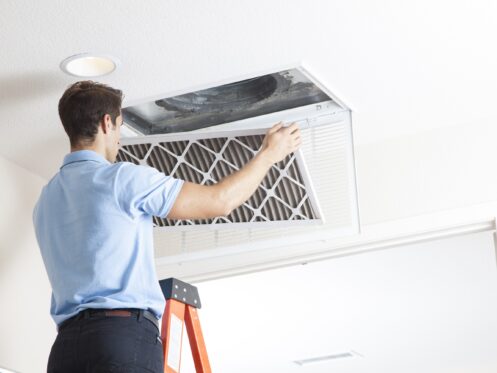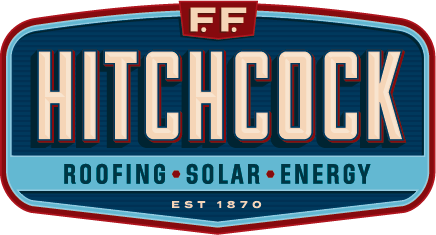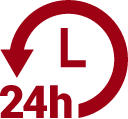Homes with forced-air furnaces and central air conditioners have ducts. Those ducts provide a path for conditioned air from the HVAC equipment to the living spaces. Well-functioning ducts will make your home comfortable, promote good indoor air quality, and lower heating and cooling costs.
HVAC Filter Choice and Changes
All HVAC systems with ducts have at least one supply vent that needs a filter. Filter choice is crucial to maintaining good air quality and keeping the system clean and efficient. Choose a high-quality pleated HVAC filter. Consider its minimum efficiency reporting value too. MERV rating is an indication of filter effectiveness. Most modern HVAC systems support MERV 13, which can trap many particles that pass through the system.
How quickly your filter clogs can depend on the season and many other potential factors. Don’t replace it on a set schedule. Instead, check it monthly or even more often. Replace it when you can see dust accumulating on the outside of the filter. That indicates the filter is full.
Clean Your Vents and Keep Them Open
Don’t close your vents, such as in unused rooms. Doing so increases static air pressure in the system. That affects airflow, comfort, and energy efficiency. Clean your vents regularly for maximum airflow. If you notice excessive dust accumulation, it may be time for a duct inspection.
Seasonal HVAC Tune-Ups
Schedule seasonal cooling and heating maintenance. Book an appointment in the spring before needing cooling. Book another in the fall before needing heating. There are a number of good reasons for this. From the perspective of your ducts, it’s all about dust and microbial growth. Even with good filter habits, dust will build up on your equipment and eventually make it into the ducts. If you have a heat pump or AC, microbial growth can build up on the evaporator coil. You can also experience mold growth in the condensate pipe and drip pan over time.
Home Energy Audits and Duct Camera Inspections
The U.S. DOE warns that typical house ductwork loses 20% to 40% of the conditioned air that passes through it. That’s why the industry recommends scheduling a duct camera inspection at least every several years. Duct inspections aren’t usually part of a seasonal tune-up, but you can often schedule these services together.
The industry also encourages a home energy audit every several years. An audit will usually include a duct inspection and an evaluation of all your HVAC equipment. Your auditor will also consider your roof, foundation, insulation, windows, and other aspects of your building envelope. Sealing and insulating your home as needed can lower energy costs by up to 30%.
Duct Cleaning
No matter how hard you try to avoid it, dust will accumulate in your ducts over time. Substantial dust accumulation is often a bigger problem than people realize. It can restrict airflow in the ducts. That changes the air pressure of the system and lessens energy efficiency. Dust also soaks up gases and airborne chemicals and continues to emit them into your air over time. Professional duct cleaning involves using an industrial vacuum to remove all the debris.
Aerosol-Based Duct Sealing
The typical duct network comprises a series of duct sections. An installer will seal those joints to avoid the air leakage the DOE warns about. The problem is that those seals can wear out over time. That can increase leakage from less than 5% to 20% or higher. One of the most effective restoration techniques is Aeroseal. Aeroseal duct sealing involves the use of a non-toxic aerosol. The U.S. EPA was involved in the development of the technology and certifies it.
Manual Duct Sealing
For some issues, manual duct sealing may be better. An example would be a puncture that’s too large for aerosol to close. For certain applications, you can use duct tape. One downside to duct tape is that it can peel up over time due to heat exposure. For a longer-lasting fix, applying mastic sealant is often the preferred option.
Duct Repairs
A common duct installation technique is to attach metal hangers to wood supports. These hangers can loosen over time, which can lead to the ducts shifting. It’s usually a relatively simple fix to reattach or replace those hangers. You may also have one or more duct walls with damage that’s not correctable through sealing. In that case, you may be able to replace those walls to avoid a full replacement.
Duct Insulation
Another type of energy loss that occurs in ducts is heat transfer between the duct walls and ambient air. If you’re experiencing that problem, insulation can eliminate it. In some scenarios, it’s only necessary to insulate exposed sections. In others, we may recommend full insulation.
Duct Replacement
Ductwork has a maximum lifespan of about 25 years. If you’ve reached that point, you should consider replacement. New ducts can save you significant money over the next 25 years. There are situations where you have to replace ducts earlier. Some ducts last only 10 or 15 years. If the condition is poor enough, it can be better to cut your losses and correct the issues comprehensively.
Mechanical Ventilation
Modern homes often have tight building envelopes, which is excellent for energy efficiency but not ventilation. In addition, many households rely exclusively on passive attic ventilation. That may not be enough, and if it isn’t, you should consider a whole-house fan. There are even fans that you can run in the winter. Heat recovery ventilators reclaim heat from stale, exhausted air and use it to preheat fresh air. Energy recovery ventilators are similar but also do that with moisture for better humidity control.
Air Purification
You can use your ducts to improve air quality throughout your home. Consider an in-duct air purifier that can filter all the air in your home four or more times an hour. These systems can often remove over 99% of particles while also absorbing odors, gases, and chemicals. You can also pair your air purifier with an in-duct ultraviolet lamp. UV lamps will neutralize over 99% of the bacteria, viruses, and other pathogens that pass through your ducts.
Humidity Control
Ductwork also provides an opportunity to control relative humidity in a home more precisely. A whole-house humidifier does that by adding moisture to the air in winter. A whole-house dehumidifier does that by removing moisture from the air in summer.
Local Duct Experts in Cheshire
If you’d like to improve your home comfort and efficiency in Cheshire, CT, F.F. Hitchcock Plumbing, Heating & Cooling is here to help. Our team performs home energy audits and provides comfort advice. We serve both residential and commercial customers. Our HVAC technicians install and fix all manner of ducted and ductless HVAC systems, including rooftop units. We install, repair, seal, clean, and insulate ducts. Our IAQ team specializes in ventilation, air purification, and humidity control.
We have an expert roofing team for inspections, installations, repairs, and solar panels. Our electricians perform inspections, installations, and repairs. That includes electrical panels, surge protection, generators, EV chargers, indoor and outdoor lighting, and appliances. We also have plumbers for draining cleaning, gas pipes, boilers, water treatment, and much more. Call today or contact us online with any questions or to schedule an appointment.








